Most innovative companies for 07/18/2023 (new inventions)
Exciting new inventions from Micron Technology, Inc., International Business Machines Corporation, Amazon Technologies, Inc., Microsoft Technology Licensing, Llc And Intel Corporation
This is a weekly article summarizing a handful of inventions from the most innovative companies in the world. The summaries are created by an A. I. and proof-read by a human before publication. Attempts are made to ensure accuracy of the descriptions, but it is very much a work in progress. Each invention description is preceeded by a poem about the invention that is written by the A. I. I have found the limerick is actually quite good at explaining the invention in simple terms. Enjoy!
****
New Weighing Sensor Ensures Accurate Scale readings
What is this invention?
Weighing sensor having a calibration weight assembly
A weighing sensor for a scale
Had a mainland body and no fail.
The levers were connected,
With coupling rods respected,
To make sure the weight didn't flail!
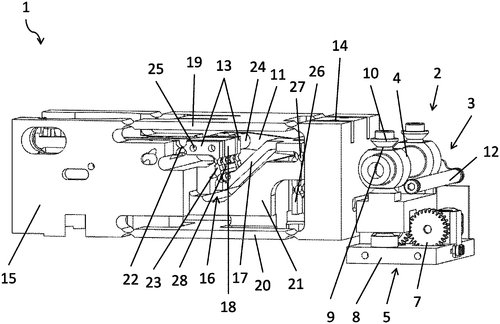
Revolutionizing Accuracy and Precision: Introducing the Weighing Sensor. Hey there tech enthusiasts! Today, I'm thrilled to discuss a groundbreaking invention that takes the accuracy and precision of scales to a whole new level. Get ready to be amazed by the innovative weighing sensor! First things first, let's break down the features of this patent-depending gizmo. This state-of-the-art weighing sensor comprises a mainland body, a load receiver, and a lever mechanism that's made up of at least two levers. These levers are supported by supporting joints on the mainland body, with the first lever positioned closer to the load receiver than the second lever. To connect the levers, coupling rods and load joints come into play. Now, what sets this weighing sensor apart from the rest is the inclusion of a calibration weight assembly. This assembly boasts a calibration weight rest and a calibration weight placed on one of the levers. But the uniqueness doesn't stop there! The calibration weight rest is connected to at least one coupling element, ensuring precise measurement every single time. Imagine having a scale that not only provides accurate readings but also offers the option to fine-tune its calibration. Whether you're a fitness enthusiast tracking your progress or a professional requiring precise measurements, this weighing sensor is an absolute game-changer. One of the most impressive aspects of this invention is the use of parallelogram guiding for the load receiver. This elegant mechanism ensures that the balance remains steady, guaranteeing reliable results. With the lever mechanism and coupling rods working harmoniously, you no longer need to worry about fluctuating weights or imprecise measurements. But here's the big question, fellow tech lovers – How can this innovative weighing sensor enhance your life? Do you see any potential applications in various industries or even everyday use? Share your thoughts in the comments below! In a world where accuracy truly matters, this patent-described weighing sensor offers a glimmer of hope for technophiles and professionals alike. Let's toast to precision and eagerly await the arrival of this game-changing device! Disclaimer: This blog-style review is purely fictional and does not represent an actual patent.
The weighing sensor for a scale includes a mainland body, a load receiver articulated on the mainland body by parallelogram guiding, and a lever mechanism having at least two levers which are supported on the mainland body by supporting joints, a first lever being arranged closer to a load receiver than a second lever. The at least two levers are connected to each other via coupling rods and load joints, and a calibration weight assembly including a calibration weight rest and a calibration weight is arranged on one lever. The calibration weight rest is connected to at least one coupling element.
US Patent 11703375
****
Sewer Line Leaks Detected Via Thermal Imaging
What is this invention?
System and method for detecting sewer lateral leaks
A sewer line and lateral inspections,
Were conducted to detect any connections.
Thermal imaging did reveal,
Leaks and ill-gotten deals,
That were found with such precision perfection!
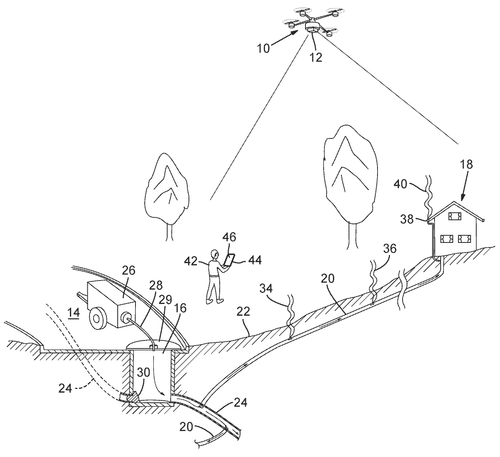
Have you ever thought about what goes on underneath the ground that we walk on every day? Well, I recently came across a fascinating patent that aims to revolutionize the way we inspect sewer lines and detect leaks and illegal connections. Yes, you read that right - sewer lines! Traditionally, sewer line inspections have been a messy and time-consuming process. But thanks to a brilliant invention, steam is injected into a section of the sewer line, and the magic begins! What's even more impressive is that thermal imaging is then used to detect any leaks or illegal connections in the vicinity. Just imagine how this innovation could make a significant difference in identifying and preventing water leaks that go unnoticed for a long time. With more accurate and efficient inspections, we could potentially save a tremendous amount of water, prevent costly repairs, and minimize the impact on our environment. Not only does this patent offer an incredibly practical solution, but it also showcases the power of technology to transform industries that we might not typically think about. It's a true testament to human ingenuity and our endless pursuit of making the world a better place. Now, I'd love to hear your thoughts on this invention. Do you think it has the potential to revolutionize the way we inspect and maintain sewer lines? Could this innovation have broader applications beyond just sewer lines? Share your insights in the comments below!
In this text, a sewer line and lateral inspections are conducted in order to detect leaks and improper connections. The thermal imaging of the vicinity indicates that there are leaks and illegal connections.
US Patent 11703412
****
Annular Space Determinations Via Negative Pressure
What is this invention?
Method for determining the free volume of an annular space of a flexible pipe and associated system
A method was described, it's true
To depressure and isolate the annular space too.
Recorded first pressure and temp'rature quite high,
Injected a given amount of measuring gas to apply.
Isolated the annular space, now negative in force,
Measured the gas then determined free volume of course!
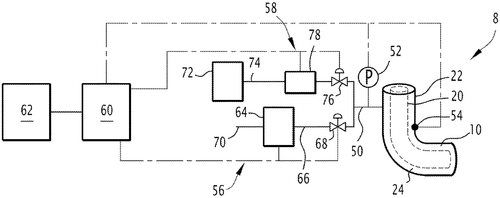
The Future of Measuring Technology: Unlocking the Hidden Potential of Annular Spaces. Hey tech enthusiasts! Get ready to be blown away by the latest invention fresh out of the patent office. Today, we're diving into a fascinating new method that has the potential to revolutionize the way we measure free volume in annular spaces. Yes, you heard it right, measuring annular spaces just got a whole lot cooler! So, what exactly is this patent all about? Well, let's break it down. The method starts with depressuring and isolating the annular space, which sets the stage for the magic to happen. First, a precise measurement of the initial pressure and temperature in the annular space is recorded - a crucial step in accurately determining its free volume. Next, brace yourselves for the injection of a measuring gas into the annular space. This gas is carefully introduced and isolated, leaving the annular space under negative pressure. But here's the exciting part – the given amount of measuring gas is then measured, providing us with valuable data. After sealing the isolation, the second pressure within the annular space is recorded. By analyzing the first and second pressure, along with temperature and the measurement of the introduced gas, the elusive free volume of the annular space is successfully determined. Incredible, right? This inventive method opens up a world of possibilities, particularly in industries where the estimation of free volume is essential. Imagine the impact this could have on the design and optimization of machinery, pipelines, and even medical devices. Precision and accuracy are key, and this patent proposes a game-changing solution. But, as always, the question remains: How might this groundbreaking technology be further developed or applied? Will it find its way into everyday devices or remain specialized? I'm genuinely curious about your thoughts! So, don't forget to share your insights and opinions in the comments section below. Innovation knows no bounds, my friends. Time and time again, we witness the birth of inventions that shape and transform our world. This patent is a testament to human ingenuity and the continuous pursuit of better, more efficient solutions. Stay tuned for more inspiring stories of technological triumphs. Until then, keep your curiosity fueled! Question for the readers: In what other fields or industries do you believe this method could have a significant impact, and how might its potential be harnessed? Let's discuss!
The method described involves depressuring and isolating the annular space, recording a first pressure and temperature prevailing in the annular space, injecting a given amount of a measuring gas into the annular space and isolating the annular space, the annular space remaining under negative pressure after the injection and isolation. The method then measures the given amount of measuring gas, records a second pressure in the annular space after the isolation of the annular space, and determines free volume on basis of first pressure, second pressure, temperature, and measurement of given amount of measuring gas.
US Patent 11703413
****
MIMO Vibration Testing System Keeps Test Results Close to Predetermined Reference
What is this invention?
High intensity vibration testing using an empirically modified reference specification and method thereof
A testing system with a MIMO,
To give the best results did try so.
The initial spec was set,
But based on results it's met,
With less power and less risk to forgo.
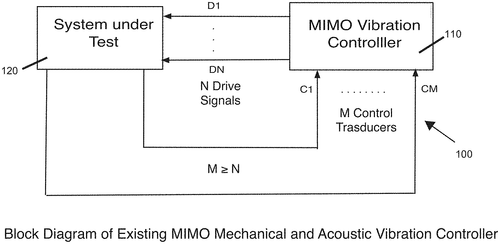
Introducing the groundbreaking acoustic or mechanical vibration testing system! This new technology is sure to revolutionize the way we conduct vibration testing. With a MIMO control system coupled to multiple controllable groups of vibration transducers and control sensor transducers, this system offers unparalleled precision and accuracy. One of the most impressive features of this system is its use of a modified reference specification. By utilizing data acquired during system operation, the modified reference specification is created based on actual system performance and limitations. This ensures that the system maintains a closer correspondence to the predetermined initial reference specification, all while requiring less system drive power. This not only optimizes the efficiency of the system but also reduces the risk of damage to both the test system and the test article during the test. Imagine the possibilities with such a system! It opens up doors for more comprehensive and reliable testing, providing researchers and engineers with valuable insights into the behavior and durability of their products. The ability to control and measure vibrations with precision allows for more accurate analysis and assessment, leading to better design and development processes. As we venture into a future full of innovation and technological advancements, this acoustic or mechanical vibration testing system stands out as a significant breakthrough. Its ability to combine advanced control systems with real-time performance data can greatly benefit various industries, from automotive and aerospace to electronics and beyond. What do you think about this new vibration testing system? Do you believe it has the potential to revolutionize the way we conduct tests and experiments? Share your thoughts and insights in the comments below!
The text describes an acoustic or mechanical vibration testing system that includes a MIMO control system. The MIMO control system uses both a predetermined initial reference specification and a modified reference specification, which is based on actual system performance and limitations. This allows for closer correspondence to the predetermined initial reference specification with less required system drive power, as well as less risk of damage to the test system and the test article during the performance of a test.
US Patent 11703415
****
Sonic sensor detects fluid characteristics
What is this invention?
System with sonic sensor for detection and monitoring of fluid processing characteristics
A sonic sensor used to detect
Characteristics of a fluid, such as density and reflect
It can assess the level of activity too,
Fermentation is what it can do!
The data from this device will be perfect.
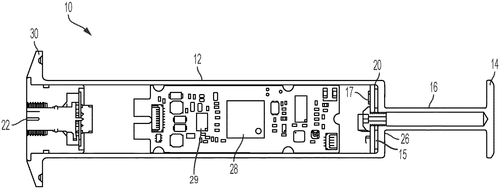
Have you ever wondered how scientists are able to determine the characteristics of a fluid without physically touching it or altering its composition? Well, wonder no more! A groundbreaking new patent has been filed for a system that utilizes a sonic sensor to detect and analyze various properties of a fluid. The sonic sensor consists of several components, including a transducer, a transduction surface, and an acoustically reflective pad member. The transducer is cleverly housed within a probe body, with the transduction surface seamlessly integrated into the body itself. A stem connects the pad member to the transduction surface, allowing for efficient transmission of pulses. So how does it work? When the transduction surface and pad member are placed in the fluid, the transducer generates pulses that are then transmitted to the pad member. These pulses are reflected back and detected by the system, enabling it to calculate the speed of sound within the fluid. This speed of sound measurement serves as the foundation for determining other important characteristics such as density, specific gravity, and even stiffness of the fluid. But that's not all - this system goes one step further, using these calculated values to assess the level of processing activity happening within the fluid. For example, it can determine the fermentation activity, giving scientists valuable insights into the state and progress of various processes. Just think about the countless applications this system can have! From the food and beverage industry to pharmaceuticals, the ability to accurately analyze and monitor fluids without invasive methods is revolutionary. It opens up new possibilities for quality control, research, and development. So, dear readers, what are your thoughts on this incredible patent? How do you envision this technology being utilized in various industries? Let us know in the comments below!
A sonic sensor is used to detect characteristics of a fluid, such as density, specific gravity and/or stiffness. The data from the sonic sensor may be used to assess a level of processing activity of the fluid, such as fermentation activity.
US Patent 11703435
Micron Technology, Inc.
Memory Subsystem Delivers Fast Media Management
What is this invention?
Multi-level wear leveling for non-volatile memory
A memory sub-system was found
To perform two media ops around.
The first with data units,
The second with groups;
For the best results, they must be sound!
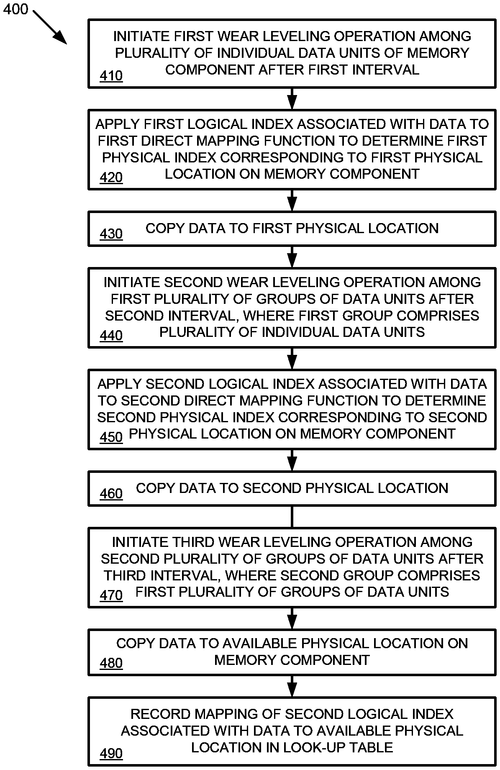
Revolutionizing Memory Management for Enhanced Performance. Hey there tech enthusiasts! Today we're diving into an exciting new patent that promises to transform memory management as we know it. Say hello to a memory sub-system that will revolutionize the way data units are organized and stored, ultimately improving overall performance and efficiency. Let's break it down. This cutting-edge memory sub-system conducts two different media management operations at specific intervals. Firstly, after a predefined period, it performs the first media management operation on a group of individual data units using a unique algebraic mapping function. This operation optimizes the way these individual units are managed, ensuring smooth and efficient data retrieval. But that's just the beginning! After another predefined period, a second media management operation kicks in. This time, it works on a set of groups, with the first group comprising the same individual data units as above. This second operation boasts a second algebraic mapping function, further enhancing the memory organization process. Imagine the possibilities this breakthrough innovation could bring! Memory devices are crucial components found in a variety of applications, from smartphones and laptops to data centers and supercomputers. By optimizing the organization and retrieval of data units, this inventive sub-system could significantly enhance the performance of these devices across the board. Think about how a hefty photo gallery or extensive video library could benefit from improved memory management. Picture your phone working seamlessly even with hundreds of apps open, or your laptop booting up lightning-fast while juggling multiple resource-intensive tasks. The potential productivity boost is truly mind-boggling! But let's not forget: as with any technological advancement, there are always questions to explore. How might this memory sub-system influence the development of future memory devices? Could this innovation pave the way for even more sophisticated memory management techniques? Share your thoughts and insights in the comments section below, and let's dive deeper into this exciting new frontier of memory technology together!
The text describes a memory sub-system that performs two media management operations. The first media management operation is between a plurality of individual data units in the memory device and the second media management operation is between a first plurality of groups of data units in the memory device. The first group of the first plurality of groups includes the plurality of individual data units. The second media management operation is between a different set of grouped data units than the first group.
US Patent 11704024
Micron Technology, Inc.
Memory Device with Variable Capacity Will Reduce Logical Memory Capacity
What is this invention?
Solid state storage device with variable logical capacity based on memory lifecycle
A memory device and system with flair,
Can have a capacity that's quite rare.
The controller will note,
When one region is near its throat,
And send a notification to beware!
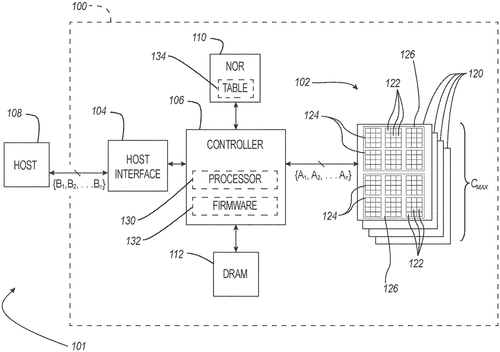
Hey tech enthusiasts! I've got some exciting patent news to share with you today. Imagine memory devices and systems that can adapt and evolve with your needs. Sounds amazing, right? Well, that's exactly what several embodiments of a new patent are proposing. In a nutshell, this patent describes memory devices with a variable logical memory capacity. What does that mean? Essentially, these memory devices come equipped with multiple memory regions that collectively define a physical memory capacity. But here's where the magic happens - the controller of the memory device has the ability to advertise a specific logical memory capacity to the host device. But wait, there's more! The controller also monitors the lifespan of these memory regions. So, if one of the regions is nearing its end of life or is already there, the controller will send a notification to the host device that the logical memory capacity will be reduced. After this notification, the controller will retire the problem region, ensuring a seamless and reliable memory experience. This patent has the potential to revolutionize memory devices and systems as we know them. Instead of being stuck with fixed memory capacities that can't be altered, we could have memory devices that intelligently adapt to our needs and ensure optimal performance. In practical terms, this could mean longer-lasting memory solutions, improved efficiency, and savings in the long run. I'm particularly excited about the implications of this patent on the future of smartphones, laptops, and other personal electronic devices. Imagine being able to upgrade your device's memory capacity without having to buy a whole new one - that would be a game-changer! Now, I'd love to hear your thoughts on this patent. Do you think this variable logical memory capacity could be a game-changer too? How do you see it being implemented in different types of devices? Let's discuss in the comments below!
Several embodiments of memory devices and systems having a variable logical memory capacity are disclosed herein. In one embodiment, a memory device can include a plurality of memory regions that collectively define a physical memory capacity and a controller operably coupled to the plurality of memory regions. The controller is configured to advertise a first logical memory capacity to a host device, determine that at least one of the memory regions is at or near end of life, and in response to the determination—send a notification to the host device that a logical memory capacity of the memory device will be reduced and then retire the at least one of thememory regions.
US Patent 11704025
Micron Technology, Inc.
Rebuilding the L2P Data Structure After Memory Cell Relocation
What is this invention?
Asynchronous power loss impacted data structure
A system and methods disclosed,
Rebuilding the L2P structure posed,
When resuming from low-power state,
The marginal cells relocated,
It's a virtual address space that needs no rebuild to recreate.
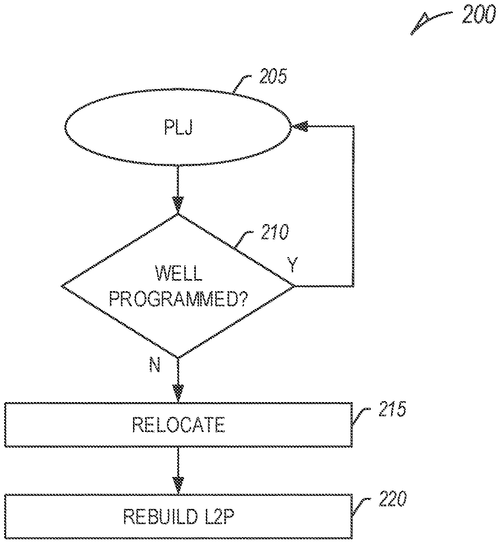
Innovating Storage System Recovery with Logical-to-Physical Data Structure Rebuilding. Hey tech enthusiasts! Today, I am thrilled to introduce an exciting technological advancement: the rebuilding of a logical-to-physical (L2P) data structure in a storage system. This cutting-edge innovation revolutionizes how we recover and resume operations from low-power states, specifically asynchronous power loss (APL). Imagine a scenario where your device experiences a sudden power failure, or perhaps you just switch it off to conserve battery life. In such situations, conventional storage systems may face challenges when trying to retrieve data and resume operations seamlessly. But fear not, as this new patent brings a solution to the table! This groundbreaking technology focuses on efficiently relocating assigned groups of memory cells within a memory array, enabling a rapid and reliable reconstruction of the L2P data structure. By doing so, the storage system is able to effectively navigate through the power loss event. To put it simply, this means that you can recover your data more effectively and get back to work or play in no time! One of the standout features of this innovation is its compatibility with low-power states. The ability to rebuild the L2P data structure while resuming operation from a low-power state, or even from an asynchronous power loss event, is a game-changer. This not only enhances the overall efficiency and reliability of the storage system but also minimizes disruptions to your user experience. Furthermore, the asynchronous nature of power loss events emphasizes the robustness of this technology. Whether it's an unexpected blackout or a quick power-off, this innovative system can handle it all seamlessly, ensuring your data remains intact and accessible. In conclusion, this patent presents an exciting evolution in storage system recovery. The ability to rebuild a logical-to-physical data structure after relocating memory cells provides a reliable solution for resuming operations from low-power states or asynchronous power loss events. This technology promises a more efficient, reliable, and seamless user experience, which is always something to celebrate in the world of tech! Now, it's your turn! What are your thoughts on this groundbreaking patent? Do you foresee any potential challenges in implementing this technology on a larger scale? Share your insights and ideas in the comments below!
Systems and methods are disclosed for rebuilding a logical-to-physical (L2P) data structure of a storage system subsequent to relocating assigned marginal group of memory cells of a memory array of the storage system, such as when resuming operation from a low-power state, including an asynchronous power loss (APL). The L2P data structure is rebuilt by identifying all physical addresses associated with the relocated marginal group of memory cells, and reconstructing the L2P data structure at each identified physical address. This allows the storage system to resume operations from the low-power state without having to rebuild any portions of its virtual addressing space.
US Patent 11704028
Micron Technology, Inc.
Memory-Optimized Storage for Your Data
What is this invention?
Elastic persistent memory regions
A system was made with two memory devices,
One held a PMR region for easy access.
The second one too had non-volatile memory,
So the first could be accessed through its entry.
This setup worked quite well in all cases!
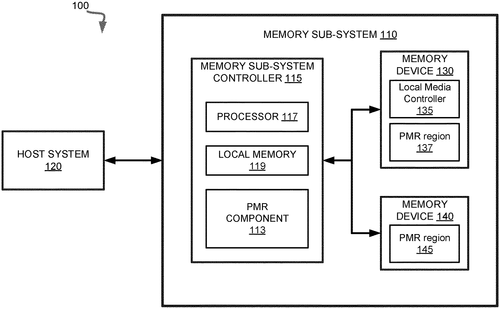
Introducing an Exciting Innovation: The PMR Mechanism. Welcome back, tech enthusiasts! Today, I am thrilled to share with you an exciting patent that could potentially revolutionize the way we interact with our memory devices. Say hello to the Persistent Memory Region (PMR) mechanism! In a nutshell, this patent describes a system that incorporates two memory devices - a non-volatile memory device and a first memory device. The first memory device features a region allocated as a PMR with its set of pages, while the non-volatile memory device has a region designated as a second PMR region with its own set of pages. The real magic happens with the implementation of the PMR mechanism, which allows the second PMR region to be accessed through the first PMR region. What does all this mean? Picture a scenario where you have multiple memory devices, like a solid-state drive and a RAM module, working in perfect harmony. Thanks to the PMR mechanism, the second PMR region in the non-volatile memory device becomes seamlessly accessible through the first PMR region in the other memory device. The implications of this technology are tremendous, as it could result in significant improvements in memory management and system performance. With the ability to access data from multiple memory devices simultaneously, we can expect faster access times, enhanced multitasking capabilities, and overall smoother user experiences. For instance, imagine you're a video editor working on a high-definition project. With the PMR mechanism, you can load your project into the first PMR region and simultaneously access data from the second PMR region without any noticeable latency. This greatly simplifies workflow and boosts productivity, making tasks like editing, rendering, and exporting a breeze. Undoubtedly, this patent holds great promise for various industries, such as gaming, scientific research, and data analytics, where memory-intensive applications are commonplace. By tapping into the potential of the PMR mechanism, we can anticipate groundbreaking advancements and seamless integration of next-generation memory technologies. So, my fellow tech enthusiasts, what are your thoughts on this innovative patent? Are you as excited as I am about the potential benefits it brings? How do you envision this technology being employed in real-world applications? Share your insights and join the conversation in the comments below!
A system includes a first memory device having a region allocated as a first persistent memory region (PMR) and a second memory device comprising a non-volatile memory device. The PMR mechanism causes the second PMR region to be accessible through the first PMR region.
US Patent 11704029
Micron Technology, Inc.
Memory System Supports Switchable Lane Directions to Increase Supported Bandwidth
What is this invention?
Switchable lane directions between a host system and a memory system
A lane's direction can be switched
To optimize the read or write which
Will make it so that
The bandwidth won't flat,
And memory and host will both stitch.
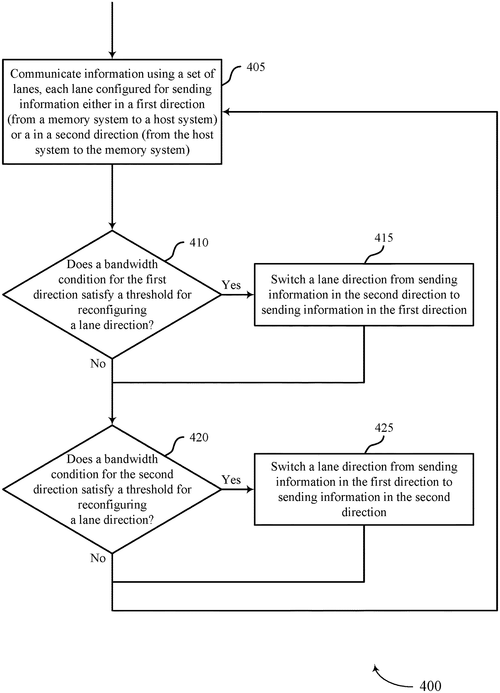
Today, I am thrilled to share with you an incredible patent that could revolutionize the way we communicate between host systems and memory systems. The patent describes methods, systems, and devices that support switchable lane directions. So, what does that mean exactly? Well, imagine a host system, like your computer, communicating with a memory system, like a storage drive. Typically, this communication is done using a set of lanes, where each lane sends information in a specific direction. But what if we could switch the lane direction to optimize the speed and efficiency of data transfer? That's where this patent comes in. By incorporating switchable lanes into both the host system and the memory system, we can dynamically reconfigure the direction of communication based on the bandwidth conditions. If a specific direction meets or exceeds a threshold, the systems can switch the configuration of a lane to prioritize either reading from or writing to the memory system. The implications of this invention are exciting. With the ability to increase the supported bandwidth in a specific direction, we can potentially enhance the performance of tasks that rely heavily on data transfer, such as gaming, video editing, or large-scale data processing. Imagine seamlessly switching your system into a "write-optimized" configuration when you need to transfer data quickly from your computer to an external storage drive. Alternatively, you could effortlessly switch to a "read-optimized" configuration when you're accessing data from your storage drive. This patent opens up a world of possibilities for improving the speed and efficiency of our technology. It's a testament to the incredible innovations happening in the field of data communication. Now, here's my question for you: How do you think this switchable lane technology could impact your everyday use of technology? Do you see any potential drawbacks or limitations? Let me know your thoughts in the comments below. I can't wait to hear your insights!
Methods, systems, and devices supporting switchable lane directions between a host system and a memory system are described. A host system may communicate with a memory system using a set of lanes, where each lane may send information (e.g., commands, operations, data) in a specific direction. In some cases, the host system and memory system may support one or more switchable lanes, where both systems include transmit and receive modules for the lane. According to a bandwidth condition associated with a specific direction satisfying a threshold for reconfiguring a lane, the host system and the memory system may switch a direction configured for the lane. Switching the lane direction may increase the supported bandwidth in a specific direction, for example from the host system to the memory system (e.g., in an “write optimized” configuration) or from the memory system to the host system (e.g., in an “read optimized” configuration).
US Patent 11704032
International Business Machines Corporation
Copy Your Data Safely and Easily with Our Library Cartridges
What is this invention?
Transparent drive-to-drive copying
A computer-implemented method was found,
To copy data from cartridge to the ground.
The cartridge loaded in the first drive,
And then it moved with ease and strive.
Data copied from one storage to another without a sound!
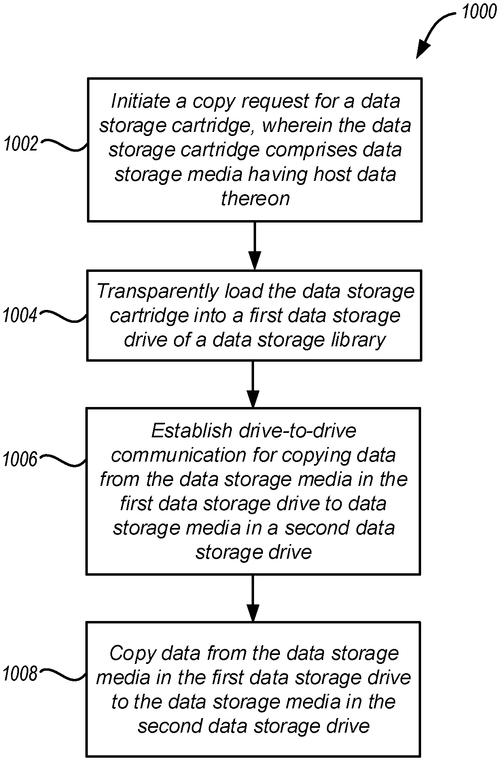
Hi there, tech enthusiasts! I've got an exciting patent to share with you today that could revolutionize the way we copy data storage cartridges. Imagine being able to seamlessly and effortlessly transfer data from one cartridge to another, without any hassle. Well, this patent aims to make that a reality! The computer-implemented method described in the patent starts with a simple copy request for a data storage cartridge. This cartridge houses important data storage media, and with this method, you can copy the data onto another cartridge with ease. The magic happens when the cartridge is transparently loaded into a first data storage drive of a data storage library. But wait, it gets better. The method establishes drive-to-drive communication, allowing you to copy data from the original storage media in the first drive to the new storage media in a second drive. Gone are the days of manually transferring data or dealing with complicated procedures. This method streamlines the whole process, making it quick, efficient, and completely hassle-free. What's impressive about this patent is its potential to simplify data management in various industries. Imagine how this method could benefit large organizations or data centers that deal with massive amounts of information on a daily basis. With this technology, copying data becomes a breeze, saving valuable time and effort for businesses. Now, let's talk about the system that accompanies this patent. It includes a processor and logic integrated with or executable by the processor. This system is specifically designed to perform the method described above, making it a powerful tool for anyone involved in data storage and management. So, readers, what are your thoughts on this patent? Do you think this method could revolutionize the way we handle data storage? Share your insights and experiences in the comments below. I'm excited to hear your perspectives and engage in a fruitful discussion!
A computer-implemented method includes initiating a copy request for a data storage cartridge. The data storage cartridge includes data storage media having host data thereon. The method also includes transparently loading the data storage cartridge into a first data storage drive of a data storage library and establishing drive-to-drive communication for copying data from the data storage media in the first data storage drive to data storage media in a seconddata storage drive. The method includes copying data from the data storemedia in the first datastore to thedata storemedia in the second datastore.
US Patent 11704040
International Business Machines Corporation
Computer System Provides Optimal Time for Updates
What is this invention?
Activity-aware update management
A request to perform an update
Was met with some priorities that were great.
The downtime was found,
And the time around bound,
So the optimal time could not be late!
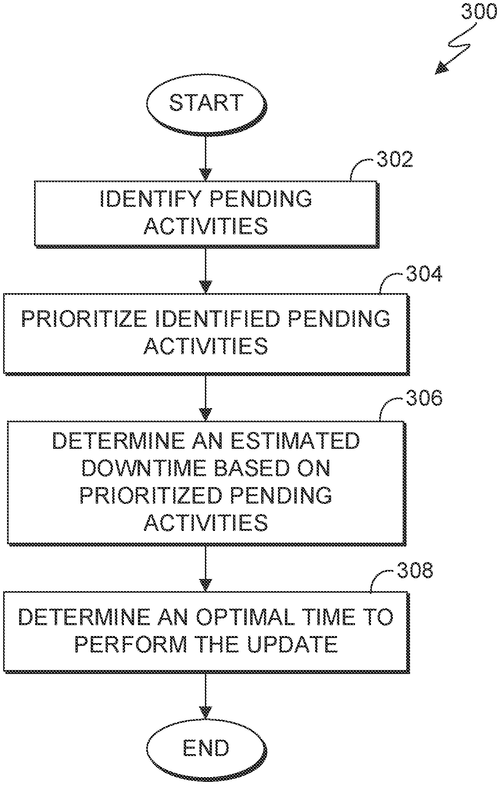
Streamlining Software Updates: A Breakthrough in Optimal Time Management. Hey there tech enthusiasts! I recently came across a fascinating patent that promises to revolutionize the way software updates are handled. As someone who gets excited about all things tech, I was intrigued by the potential of this invention to streamline processes and enhance efficiency. Embodiments of this innovation provide a computer-based approach to managing software updates. Upon receiving a request for an update, the system analyzes the priorities of pending activities. But here's where it gets really interesting: the system then determines an optimal time for the update to occur based on the estimated downtime duration and the remaining tasks on hand. Imagine a world where software updates seamlessly fit into your existing workflow, causing minimal disruption and maximizing productivity. No more frustrating interruptions or delayed deadlines due to unplanned system maintenance! This invention has the potential to significantly improve efficiency in organizations of all sizes. However, as with any groundbreaking invention, there are a few questions that come to mind. How accurately can this system predict the downtime duration associated with an update? Are there any potential pitfalls or challenges that might arise when integrating this technology into existing software management systems? So, dear readers, I'd love to hear your thoughts! Can you envision the benefits of such a system in your own work or personal life? Do you foresee any potential obstacles that could hinder its adoption? Share your insights and join the discussion in the comments below! Tech-savvy readers unite! Let's delve into the possibilities and challenges of this patent and envision a more efficient future together!
Embodiments of the present invention provide computer-implemented methods, computer program products and computer systems. In response to receiving a request to perform an update, embodiments of the present invention can identify priorities of pending activities. Embodiments of the present invention can then determine a downtime duration associated with the update. Embodiments of the present invention can then determine an optimal time to perform the update based, at least in part, on the determined downtime duration and the pending activities.
US Patent 11704108
International Business Machines Corporation
Analyzing Applications for Modernization: Processor Units Find Issues and Cost
What is this invention?
Application modernization
A method for modernizing apps
Analyzes each one with a few saps
It takes into account
That common code's amount
Will save costs when applications adapt.
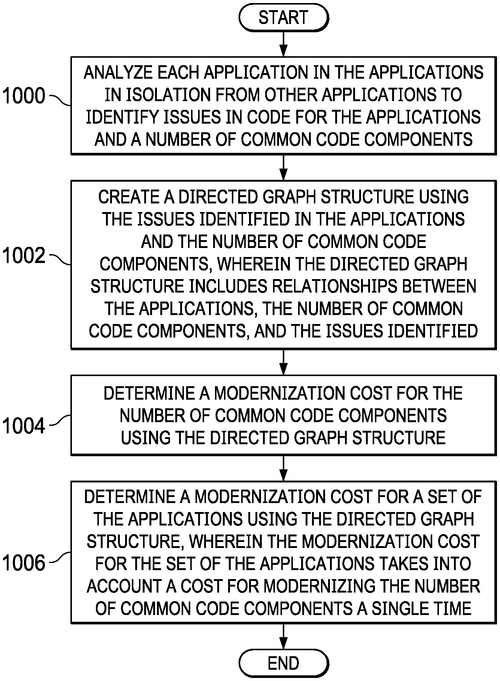
Streamline Application Modernization with Innovative Analytical Method. Hey tech enthusiasts! Are you ready for another mind-blowing innovation in modern technology? I've got something exciting to share with you today that will revolutionize the way we analyze and modernize applications. A recently published patent describes a method that promises to make application modernization a breeze! The heart of this invention lies in its processor units, which work tirelessly to analyze each application individually, without any interference from other applications. By doing so, it identifies any existing issues in the code as well as the presence of common code components. But here's the kicker - these processor units go beyond identification and actually create a directed graph structure based on the issues and common components discovered. This directed graph structure is a game-changer. It establishes relationships between the applications, the number of common code components, and the identified issues, providing a holistic and comprehensive view. With this bird's eye view of the application landscape, the processor units can then determine the modernization cost of the common code components and the entire set of applications. This optimization also considers the cost of modernizing these common code components only once. Think about it: gone are the days of laboriously analyzing each application in isolation without considering their dependencies and shared elements. Now, with this method, we have an efficient and accurate approach to assess modernization costs. Not only does it save time, but it also ensures that no application is left behind, streamlining the modernization process as a whole. But let's not stop here - the possibilities are endless! This innovation has the potential to transform various sectors, from software development to system upgrades. Imagine how swiftly we could update and enhance multiple applications, all while keeping an eye on the costs involved. So, my fellow tech enthusiasts, what are your thoughts on this groundbreaking patent? Can you envision any other potential applications for this analytical method? Share your ideas and let's dive deep into the potential of this innovation in the comments below!
This method analyzes applications for modernization and determines a common code component modernization cost and an application modernization cost for a set of the applications. The common code component modernization cost takes into account the fact that modernizing the number of common code components a single time is cheaper than updating each application individually.
US Patent 11704118
International Business Machines Corporation
Automatically Migrating Infrastructure as Code
What is this invention?
Migrating infrastructure as code between different cloud providers
A method to migrate IaC
From one cloud platform to the next,
Using NLP and ML,
To translate with great skill,
The code from one type to the rest.
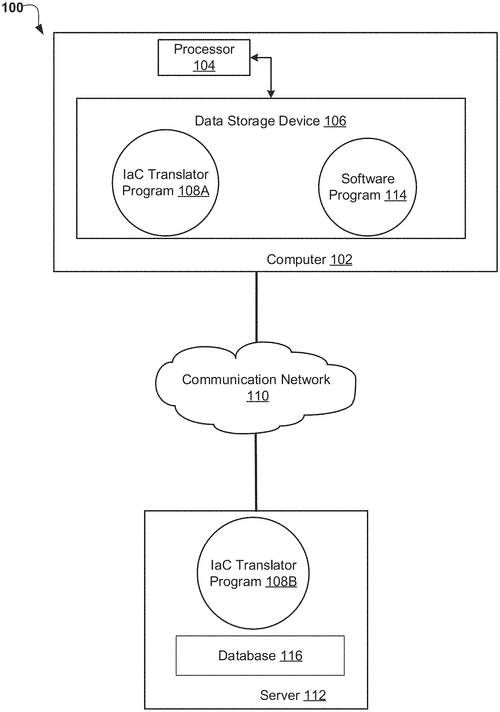
Streamlining Cloud Infrastructure Migration: A Breakthrough in Infrastructure as Code (IaC) Automation. Hey tech enthusiasts! Today, I'm thrilled to share with you an exciting patent that promises to revolutionize the way we migrate our infrastructure as code (IaC) between different cloud platforms. This groundbreaking method for automatic migration is set to save developers valuable time and effort while ensuring seamless transitions from one cloud infrastructure platform to another. So, what exactly does this patent offer? Let's dive in! The process begins by receiving the original IaC code, which is written in a specific coding language. Here's where things get really fascinating: natural language processing (NLP) comes into play to establish a connection between the original coding language and the destination coding language used in the target platform. This means that the system intelligently understands the similarities and differences between the two languages, bridging the gap for a successful migration. Using this mapped connection, the NLP algorithm then generates a partial translation of the original code into the target coding language. But wait, there's more! To ensure accuracy and efficiency, a machine learning algorithm comes into action. It works tirelessly to spot any inaccuracies in the partial translation and corrects them, making sure that the final output is flawless. With the accurate and complete translation in hand, the system now empowers developers to implement their second IaC on the new cloud infrastructure platform. This streamlined automation process drastically reduces the manual effort required for migration and ensures a more efficient transition without compromising code integrity or functionality. This innovative method is set to have a significant impact on the cloud computing landscape, allowing developers to explore different cloud platforms without being hindered by language constraints. It's all about enabling seamless flexibility and the freedom to choose the cloud environment that best suits our needs. Now, let me leave you with a thought-provoking question: How could this automated infrastructure migration technique impact the adoption of new cloud platforms? Would it encourage developers to explore and experiment with a wider range of options? Share your insights and opinions in the comments below. Let's envision the future of cloud computing together!
The method for migrating infrastructure as code (IaC) from a first cloud infrastructure platform to a second cloud infrastructure platform is described. The original IaC may comprise a first type of coding language, and the NLP may be used to map a connection between the first type of coding language and a second type of coding language. The machine learning algorithm may be used to correct at least one inaccuracy in the partial translation. The complete translation of the original IaC may then be generated and implemented on the second cloud infrastructure platform based on the mapped connection.
US Patent 11704119
International Business Machines Corporation
Container Scaling and Migration: Predicting Future Needs and Assigning Labels
What is this invention?
Automated orchestration of containers by assessing microservices
A system of container scaling was provided,
Features extracted from each microservice side.
Forecasting model predicted the number required,
A scaling label and value assigned as desired.
The current containers adjusted with pride!
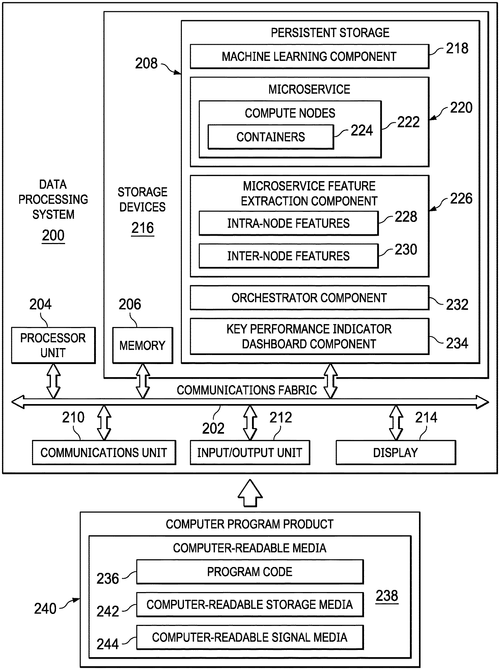
Are you ready to take your container-based microservices to the next level? Look no further because a groundbreaking technology has just been patented that promises to revolutionize container scaling and migration. This innovative system takes advantage of machine learning and forecasting models to predict the optimal number of containers required for each microservice in the future. So, how does it work? First, a set of features is extracted from each microservice in your diverse collection. These features serve as the basis for the forecasting model, which uses machine learning techniques to predict the number of containers needed for each microservice at a specified future point in time. This predictive capability empowers you to make informed decisions about scaling your microservices, ensuring that you can meet future demands with precision and efficiency. But that's not all. The system goes beyond prediction by assigning a scaling label and value to each microservice based on the predicted change in the number of containers. This helps you understand the potential impact of scaling on each individual microservice. By adjusting the current number of containers based on these labels and values, you can optimize your container allocation and ensure smooth operations across your microservices. This patent brings a much-needed solution to the complex and ever-evolving world of container-based microservices. With the ability to predict and adjust container scaling, you can say goodbye to overprovisioning or being caught off guard by unexpected increases in demand. This technology is a game-changer for both developers and businesses, providing them with the tools they need to scale efficiently, save costs, and deliver an exceptional user experience. So, dear reader, what challenges have you faced when it comes to container scaling for microservices? How do you envision this patented technology benefiting your organization? Share your thoughts in the comments below!
Container scaling and migration is provided. A first set of features is extracted from each respective microservice of a plurality of different microservices. A number of containers required at a future point in time for each respective microservice of the plurality of different microservices is predicted using a trained forecasting model and the first set of features extracted from each respective microservice. A scaling label and a scaling value are assigned to each respective microservice of the plurality of different microservices based on a predicted change in a current number of containers corresponding to each respective microservice according to the number of containers required at the future point in time for each respective microservice. The current number of containers corresponding to each respective microservice of the plurality of differentmicroservices is adjusted based on the scaling label and the scaling value assigned to eachrespectivemicroservice.
US Patent 11704123
Amazon Technologies, Inc.
Determining Positions of Devices Within an Environment with Bluetooth®
What is this invention?
Determining relative positions of user devices
A service to find out their place,
For devices in an office or space.
The data it will capture,
To determine the distance and rapture,
Of Zigbee and Bluetooth with a trace.
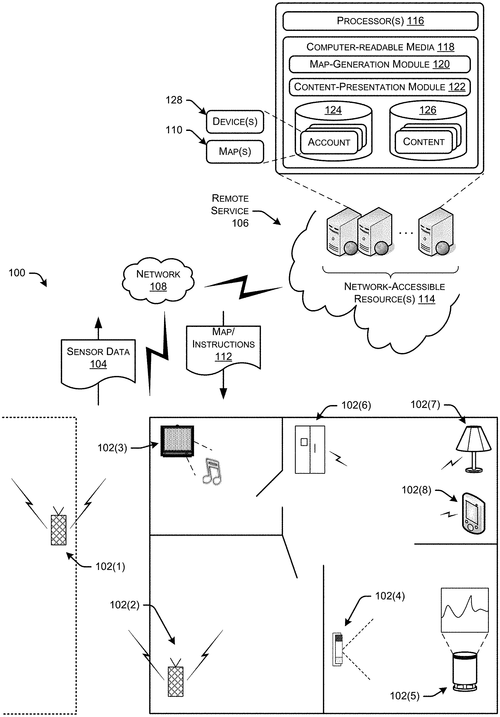
Revolutionizing Device Positioning: A Glimpse into the Future. Are you tired of constantly searching for that misplaced remote control or struggling to find your smartphone buried under a pile of cushions? Well, get ready to bid farewell to those woes because a groundbreaking patent has surfaced, promising to transform the way we track the positioning of devices within our homes and offices. The patent titled "Techniques for determining positions of devices within an environment" brings to light an ingenious solution that harnesses the power of our interconnected devices. Picture this - an array of devices, from smart TVs to smart speakers, all seamlessly communicating with each other via short-range wireless connections like Bluetooth and Zigbee. They not only share data with each other, but also send it to a central service. This central service acts as the brain behind the operation, analyzing the data streams from these interconnected devices with precision and finesse. By leveraging this data, it determines the exact location of each device relative to the others. In simpler terms, it can calculate the distances and orientations between them, providing an accurate map of your device landscape. Imagine the possibilities! No more frantic searches or frustrating moments wasted trying to locate our gadgets. Thanks to this patent, our devices will now be able to automatically identify their positions within our surroundings. Beyond the everyday convenience this innovation brings, it opens up a world of potential applications. For example, imagine your smart home automatically adjusting lighting and temperature settings as you move from room to room, creating an environment perfectly tailored to your needs. Or, consider a scenario where your devices collaborate to deliver a truly immersive entertainment experience, adjusting sound and visuals based on your precise location within the room. However, as with any technological advance, there are always questions to explore. How do you envision this device positioning technology improving your daily life? Are there any concerns you have about privacy or security when it comes to devices analyzing and sharing data? I look forward to reading your thoughts and engaging in a fascinating discussion in the comments section below!
This document describes techniques for determining the positions of devices within an environment. For example, a home or office of a user may include an array of devices, some or all of which may couple to a network or to other devices via short-range wireless connections (e.g., Bluetooth®, Zigbee®, etc.). The central service may analyze the data captured by these devices and determine their relative distances and orientations within the environment.
US Patent 11703320
Amazon Technologies, Inc.
Device Keeps Camera Running in Low Power Mode to Detect Motion
What is this invention?
Reduced radar sensor power consumption
A device with a camera, processor and radar
It had three modes for power to guard
Low-power mode it used most of the time
But when movement was found in its prime
The second mode would consume more power instead of just dime.
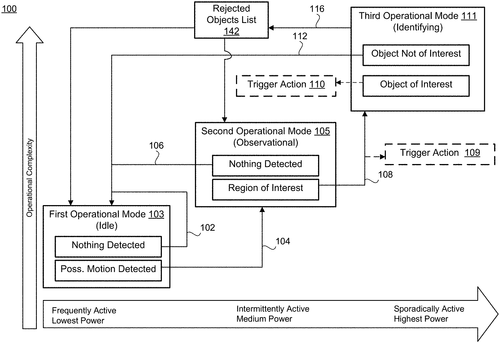
A Game-Changing Video Recording and Communication Device. Hey tech enthusiasts! Today, I am thrilled to introduce a groundbreaking video recording and communication device that is set to revolutionize the way we capture and interact with the world around us. Imagine a device equipped with a camera, a processor, a radar sensor, and memory, all working seamlessly together to deliver an unparalleled user experience. This cutting-edge invention boasts an intelligent feature that optimizes power consumption while ensuring no important moments are missed. The device operates in three different modes, each strategically designed to conserve power and capture high-value content. First, we have the low-power mode, where the camera remains dormant, waiting for any indications of movement within a certain range. As soon as the radar sensor detects possible motion within the threshold distance, the device swiftly transitions to the second operational mode. In this second mode, the device consumes more power but ensures that every detail is captured at the right time. The radar sensor comes to life, accurately determining whether the detected motion occurred in a region of interest. This outstanding functionality separates this device from its competitors, as it saves energy by focusing only on capturing motion in areas that matter most. Lastly, once the device has confirmed the importance of the detected motion, it transitions into the third operational mode, consuming even more power than before. This mode kicks in to enable the device to fully capture and record the event, guaranteeing precious moments are preserved with utmost clarity and detail. This patent represents a major leap forward in the field of video recording and communication devices. Its ability to intelligently optimize power consumption while capturing crucial content showcases the inventive minds behind this creation. Now, I'd love to hear your thoughts! How do you think this innovative device will impact our daily lives? Do you anticipate any potential challenges or improvements that could be made to enhance its functionality even further? Share your valuable insights in the comments below!
The text describes a video recording and communication device that includes a camera, a processor, and radar sensor. The processor executes instructions from memory to cause the device to operate the sensor in three different modes: low-power mode, first operational mode, and second operational mode. In the low-power mode, the camera is maintained in order to conserve power. If there is possible motion of an object within a threshold distance from the sensor in the first operational mode, then the processor will transition the sensor to the second operational mode which consumes more power. If there is no possible motion of an object within a threshold distance from the sensor in either of these two modes, then the processor will stay in the low-power mode. The third operational mode is used when it is determined that there may be possible movement of an object within a region of interest by using radar sensors. This higher poweredmode consumes more power than either ofthe other two modes
US Patent 11703583
Amazon Technologies, Inc.
Autonomous Surface Vehicle Operates Within Inventory System in Environment
What is this invention?
Inventory system with high-speed corridors for autonomous surface vehicles
An autonomous surface vehicle, ASV
Had a drive system, docking and more
It could detect its location
And speed through the ocean
At first it went slow but then sped up galore!
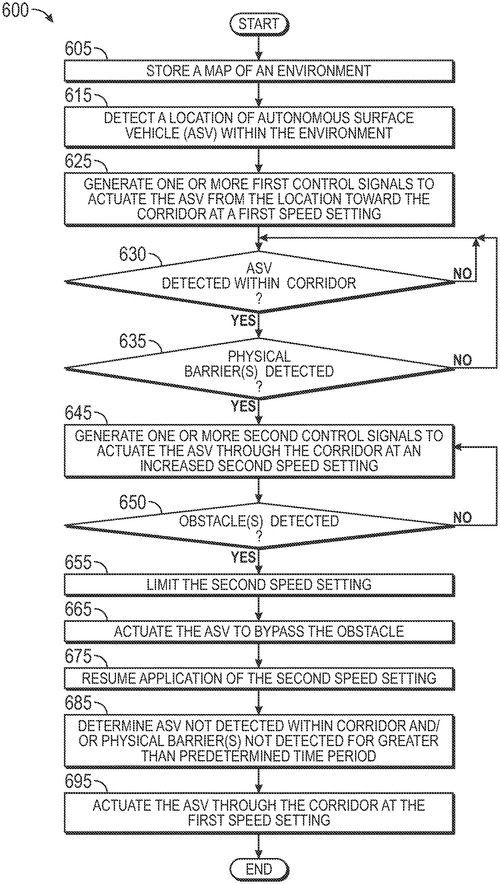
Are you tired of long and tedious inventory checks? Well, get ready to be amazed because a new invention is here to revolutionize the way we manage inventory systems. The patent described here introduces an Autonomous Surface Vehicle (ASV) that is designed to operate within an environment's inventory system. The ASV is equipped with a drive system, a docking system, a variety of sensors, and a memory that stores a map of the environment. But what makes this technology truly remarkable is its ability to navigate through the environment autonomously, with minimal human intervention. Using its location sensor, the ASV can detect its position within the environment. It then utilizes its computer processors to control the drive system, directing the vehicle towards specific corridors defined in the map at a set speed. But here's where it gets even more fascinating - once the ASV enters a corridor and detects fiducials (visual markers) along the barriers using proximity sensors, it automatically switches to a higher speed setting, allowing it to swiftly move through the corridor. Imagine the time and effort saved by having this autonomous vehicle swiftly maneuver through corridors, checking inventory and collecting data along the way. It's like having a tireless assistant that can tirelessly scan and compile inventory information while you focus on other important tasks. This technology has the potential to revolutionize inventory management in various industries, such as warehousing, logistics, and retail. With increased efficiency and accuracy, businesses can optimize their inventory management processes, reduce costs, and provide better customer service. But as exciting as this invention is, there are always questions to ponder. How do you envision this technology transforming the way we manage inventory? Can you think of any potential challenges or limitations that could arise with the implementation of autonomous surface vehicles in inventory systems? Share your thoughts and insights in the comments below!
The autonomous surface vehicle (ASV) described herein includes a drive system, a docking system, sensors, and memory. The ASV is configured to detect its location within an environment, control the drive system to actuate the ASV toward a corridor defined in the map at a first speed setting, and control the drive system to actuate the ASV through the corridor along at least one barrier defined in the map. A second speed setting is applied when one or more fiducials along the at least one barrier are visually detected by one or more proximity sensors.
US Patent 11703861
Amazon Technologies, Inc.
Detect touch and hover events with radar units instead of integrated capacitive sensing
What is this invention?
Touch detection using radar
A tech that uses radar units,
To detect touch events on devices plus;
Forget capacitive sensing,
It's the first data bringing,
The results of hover events above us.
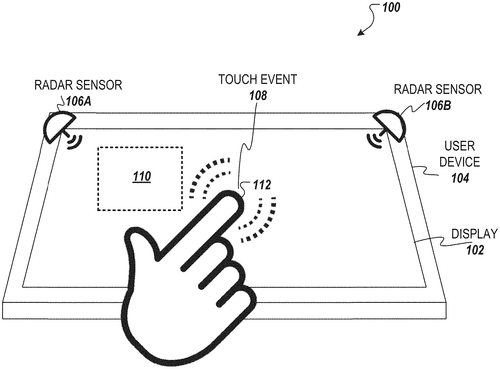
Revolutionizing Touch Technology: Radar Units as the Future of Electronic Devices. Hello tech enthusiasts! Today, I am thrilled to share with you an incredible innovation in touch technology that takes a giant leap towards the future. Imagine a world where we no longer rely on capacitive touch sensors in our electronic devices, but instead, utilize radar units to detect touch and hover events. Sounds like science fiction, doesn't it? Well, my friends, it's now a reality. This remarkable patent introduces a breakthrough concept that revolutionizes the way we interact with our electronic devices. By replacing conventional touch sensing technologies with radar units, this invention opens up a whole new realm of possibilities. Gone are the days of limited touch sensitivity and accidental touches. Brace yourselves for an enhanced user experience like never before. So, how does it work? Picture an electronic device equipped with a display along a first plane. Now, add a radar unit seamlessly integrated with the display. This radar unit is specifically designed to have a field-of-view aligned with the first plane, ensuring accurate detection and response. Additionally, a processor is incorporated into the device, which receives data from the radar unit and interprets it to identify touch events associated with the display. The implications of this technology are mind-boggling. Imagine effortlessly navigating through your smartphone or tablet using gestures in mid-air, without even touching the screen. Sounds futuristic, right? This patent takes us a step closer to making that a reality. Not only does it offer a more intuitive and seamless interaction, but it also opens up doors for improved accessibility, making it possible for individuals with limited mobility to effortlessly engage with their devices. As a technology enthusiast, I can't help but wonder about the endless possibilities this patent presents. How will this innovation impact the way we use our electronic devices? Will it pave the way for more interactive and immersive experiences? Will it eventually render traditional touchscreens obsolete? I encourage you, my fellow tech lovers, to share your thoughts and predictions in the comments below. Let's dive into this exciting journey together and envision a future where our devices respond to our every touch and hover, driven by the power of radar technology. The possibilities are truly infinite.
Technologies are described for detecting touch events on or hover events above a surface of an electronic device using radar units instead of integrated capacitive touch sensing technologies. The first data received from the radar unit is used to determine the touch event.
US Patent 11703986
Amazon Technologies, Inc.
Keep your data organized with our systems and methods for managing data partitions in a distributed storage system!
What is this invention?
Request routing management for a distributed storage system
A paper discussed methods to store,
Where data is grouped in different cells galore.
The routing must change when partitions move,
So a special record's written for the groove.
It ensures that data goes right where it should go;
Then all of the nodes can proudly show!
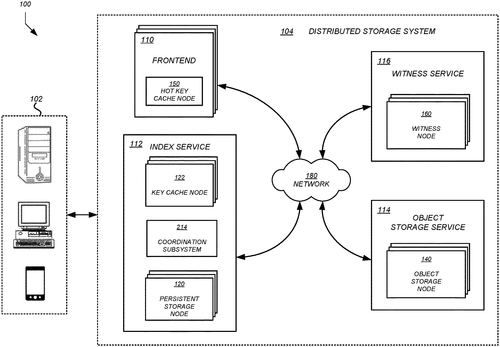
Innovative System for Efficient Data Partition Management in Distributed Storage. Hey there tech enthusiasts! Today, we have an exciting patent to discuss that focuses on the efficient management of data partitions in a distributed storage system. This innovative system enhances the routing of data within the system, ensuring smooth operation and optimal performance. So, what exactly does this patent offer? Well, it introduces a method of grouping data items into different partitions based on their key prefixes. These partitions are then organized into cells according to key ranges. This multi-tier configuration enables seamless management of data throughout the distributed storage system. One fascinating aspect of this patent is its ability to handle the movement of partitions from one cell to another or the splitting of cells. When such changes occur, the routing data is automatically updated to reflect the new configuration. By doing so, the system maintains accuracy and consistency in directing requests to the appropriate caching layers and persistent storage nodes. To ensure that the correct routing data is consistently used, a remarkable feature is implemented. Whenever a change in the routing data occurs, a special barrier record is written to the transaction log of affected partitions. This barrier record acts as a marker, indicating that a change has taken place, and guarantees the integrity of the data. With this patent, we witness a significant advancement in the management of distributed storage systems. By efficiently organizing data partitions and implementing seamless routing updates, the overall performance and functionality of the system are enhanced. Now, here comes the intriguing question for our readers: How do you think this patent could potentially revolutionize the world of distributed storage systems? Leave your thoughts and ideas in the comments below!
This paper discusses methods for managing data partitions in a distributed storage system. Partitions are grouped into different cells based on key ranges, and when partitions are moved from cell-to-cell or cells are split, the routing data is changed accordingly. This ensures that the correct data is routed to the appropriate caching layers and persistent storage nodes. A change to routing data may be accompanied by a special barrier record being written to the transaction log of affected partitions.
US Patent 11704033
Microsoft Technology Licensing, LLC
Crop your way to success with new window cropping application
What is this invention?
End-user created cropped application window
A present technology provides a crop
To an application window, quite a prop.
It allows the user to take
Just what they need for their sake,
And makes working across windows less of a flop!
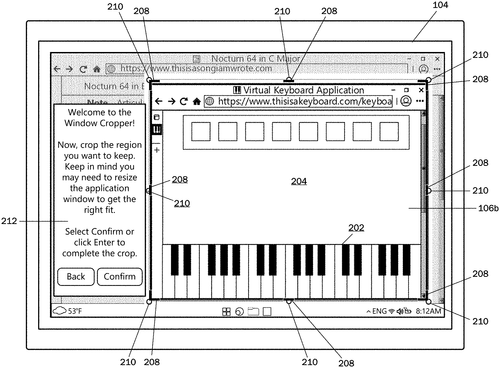
Introducing a patent that is set to revolutionize the way we interact with applications and windows on our devices! The "Systems and methods for providing a cropped application window of an application window" is an exciting technology that aims to enhance multi-window scenarios, particularly on small screen devices. Have you ever wished that you could focus on just a specific part of an application window, rather than having to deal with the entire window? Well, this patent brings that dream to life! With this technology, users will be able to crop and isolate the portion of an application window they are interested in and place it in an area of the display with enduring visibility or accessibility. This means that you can have the play controls of your favorite music app or a chat window from a gaming app always at your fingertips, even when you switch to other applications. But it doesn't stop there! This incredible technology can also be applied to web pages, document pages, and various other scenarios. Imagine being able to crop and save important snippets from tutorial articles or reference images, or easily access a calculator tool without having to switch between different tabs or windows. The possibilities are truly endless. One of the key benefits of this patent is its ability to improve multi-window scenarios, especially on small screen devices where screen space is limited. By allowing users to focus on specific parts of each window, it enhances ease of use and streamlines the process of working across different applications. Composing windows becomes a breeze with this innovative solution. I, for one, am extremely excited about this patent and the potential it holds for improving the efficiency and convenience of our digital experiences. No longer will we need to navigate through cluttered windows or struggle with limited screen real estate. With this technology, we have the power to customize our display and optimize it for our specific needs. Now, over to you, dear reader. What are your thoughts on this patent? Can you imagine how this technology could enhance your daily interactions with applications and windows? Share your insights in the comments below!
The present technology provides a cropped application window of an application window. The system includes a window cropping application that performs a method that allows a user to crop just the portion of an application window the user is interested in (e.g., play controls for a music app, chat window in a gaming app) and place it in an area of the display with enduring visibility or accessibility (e.g., widget dashboard, desktop). This allows users to work across different windows and applications more easily and improve the ease of composing each window.
US Patent 11703989
Microsoft Technology Licensing, LLC
Animated previews help you choose what to see
What is this invention?
Animated visual cues indicating the availability of associated content
A system has been created to view
Associated content in a chat room too
It can generate cues
To show when it's new
So you won't miss any updates that ensue
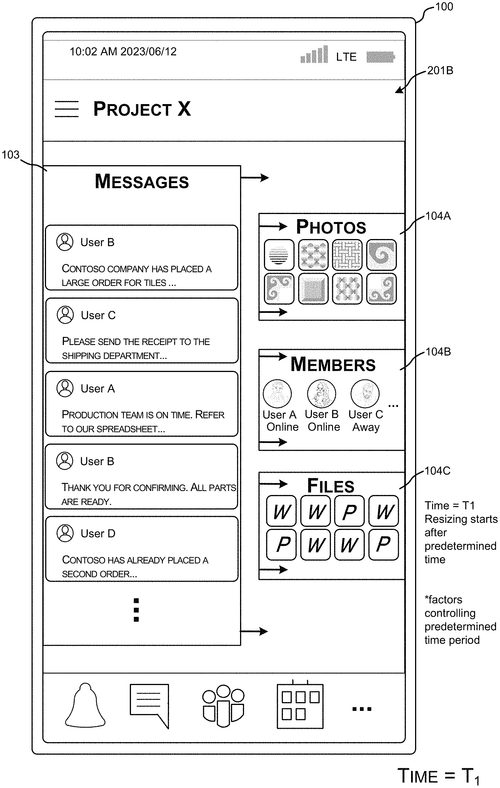
Hey tech enthusiasts! I have some exciting news to share with you today. A new patent has been filed for a system that generates animated visual cues to provide previews for associated content. This means that we may soon have a more dynamic and interactive way of accessing specific information! Imagine this scenario: you are in a chat session and want to view some selected content, such as messages. With this system, instead of directly jumping into the content, a visually stunning landing page will be displayed. On this landing page, you will find an animated preview of associated content, like files related to the chat session. This simultaneous display of previews and selected content adds a whole new level of convenience and engagement. But it doesn't stop there! The patent also introduces the concept of a visual bounce cue. Let's say you are viewing a chat session UI with messages displayed. If there are updates to associated content, like new files added, the chat session UI will perform a controlled animated movement to alert you. This provides a seamless and intuitive way to stay informed about any updates without interrupting your current browsing experience. I find this patent truly fascinating because it showcases the potential of technology to enhance our daily interactions. The ability to see previews of associated content can save us time and effort by allowing us to decide which information we want to explore further, without having to switch between multiple screens or windows. Now, it's your turn to share your thoughts! What do you think about this new system that generates animated visual cues for previews? Do you believe it will improve the way we interact with content? Let me know in the comments below!
The system described herein provides a way to generate previews of associated content, such as files related to a chat session. This can be done in a way that is concurrent with the selection of the content for viewing. In addition, this system can also generate visual cues indicating when salient content has been updated, which can be helpful for users who are viewing selected content.
US Patent 11703990
Microsoft Technology Licensing, LLC
Virtual Object Visited by Far Away User Triggered Near Mode
What is this invention?
Near interaction mode for far virtual object
A computing system was made,
With a HMD device displayed.
To the user it showed,
A virtual object that glowed.
Interaction mode invoked when its control points exceeded!
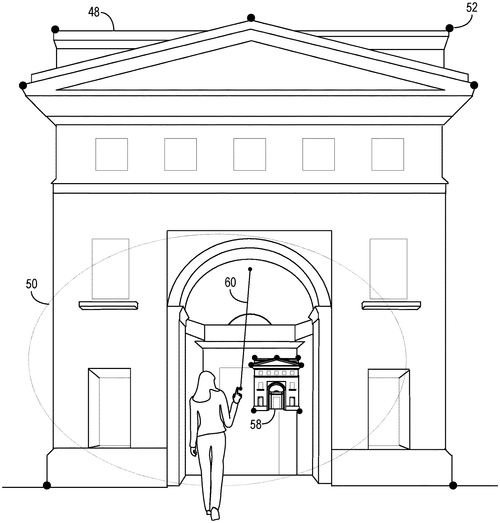
I am always amazed by the constant advancements in technology that make our lives more exciting and convenient. Today, I want to share with you a patent that describes a fascinating computing system with head-mounted display (HMD) technology. This computing system takes the immersive experience of virtual reality to the next level. It includes a display and a processor that can execute various programs. The processor is capable of projecting virtual objects within the user's field of view on the display. But what sets this system apart is its ability to adapt based on the user's interaction. Imagine you're using this head-mounted display, exploring a virtual environment and interacting with virtual objects. The processor can identify control points associated with these objects, allowing you to manipulate and engage with them. However, here's where it gets really interesting: the processor can determine if these control points are too far from you. If the control points are beyond a certain distance, the processor shifts into what they call a "far interaction mode." In this mode, you can trigger an interaction with a virtual object that appears closer to you, invoking what they call a "near interaction mode." This means that even if an object is technically far away in the virtual world, it can feel within reach to you, creating a more immersive and natural experience. Just think of the possibilities this could open up! It could revolutionize gaming, virtual training programs, and so much more. The ability to interact with objects as if they were right in front of us could truly blur the lines between the real and virtual world. Now, I'd love to hear your thoughts on this patent. Do you think this type of technology will change how we experience virtual reality? How do you imagine it being utilized in different fields? Share your insights in the comments below!
The invention provides a computing system that includes a head mounted display (HMD) device including a display and a processor. The HMD device is configured to display a virtual object at least partially within a field of view of the user on the display, identify a plurality of control points associated with the virtual object, and determine that one or more of the control points associated with the virtual object are further than a predetermined threshold distance from the user. In response to this determination, the processor is configured to invoke an interaction mode for the virtual object, such as far or near. When invoked in far interaction mode, the processor is configured to receive input from the user via trigger input. Conversely, when invoked in near interaction mode, the processor is configured to display an interactive virtual object within predetermined threshold distance from user.
US Patent 11703994
Microsoft Technology Licensing, LLC
Reference Accumulator Output vs. Hardware Result: How Close Can You Get?
What is this invention?
Techniques for conformance testing computational operations
A conformance test for operations,
Can be done with precision and patience.
Inputs are taken, and a hardware result is made.
Then the variance can be weighed.
If it passes then you'll have success,
But if not you'll need to assess!
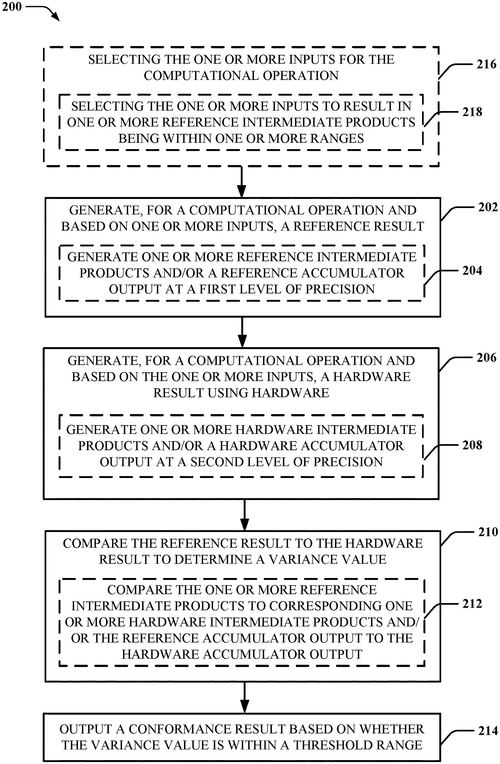
Hey there tech enthusiasts! I've come across a fascinating patent that focuses on performing conformance testing of computational operations. This means that it's all about ensuring that the results we get from our calculations are accurate and within a certain level of precision. How cool is that? So, let me break it down for you. The patented technology allows for the generation of a reference result, which includes intermediate products and an accumulator output, all at a specific level of precision. This reference result is created based on the computational operation and one or more inputs. Now, here's where it gets interesting. The hardware used in the process also generates a result, but at a different level of precision. This hardware result is then compared to the reference result to determine a variance value. This variance value acts as an indicator of how closely the hardware result matches up with the reference result. But wait, there's more! Based on this variance value, a conformance result is outputted. This conformance result essentially tells us whether the variance value falls within a specific threshold range. If it does, it means that the hardware result is within an acceptable range of accuracy. I find this patent incredibly exciting because it addresses an important aspect of computational operations - ensuring accuracy. With advancements like this, we can have more confidence in the results we obtain, particularly in areas where precision is crucial. Now, here's my question for you: How do you think this technology could impact industries that heavily rely on computational operations, such as finance or scientific research? Share your thoughts in the comments below! Until next time, tech enthusiasts. Keep exploring and embracing these amazing innovations!
The text describes methods for performing conformance testing of a computational operation. A reference result including one or more reference intermediate products and a reference accumulator output at a first level of precision can be generated for the computational operation and based on one or more inputs. A hardware result can similarly be created using hardware at a second level of precision. The reference result can be compared to the hardware result to determine a variance value. A conformance result can be output based on whether the variance value is within a threshold range.
US Patent 11704231
Microsoft Technology Licensing, LLC
Performing Speculative Address Translation in Processor-Based Devices
What is this invention?
Performing speculative address translation in processor-based devices
A processor-based device's the case,
With a PE that enqueues in its space.
It speculatively translates
The virtual memory states,
And if any errors arise they'll raise an ace.
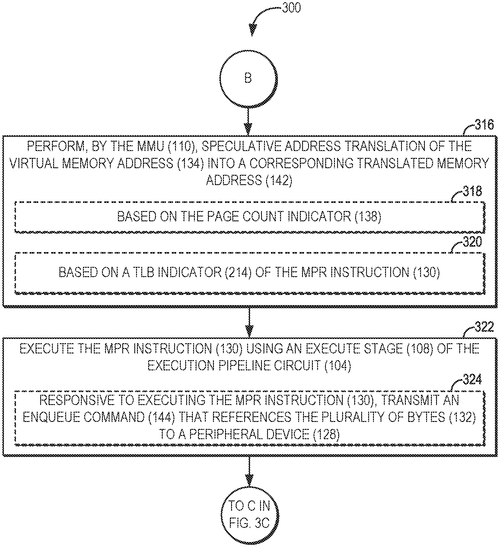
Exploring the Future of Processor-Based Devices: Speculative Address Translation. Greetings, tech enthusiasts! Today, we delve into the fascinating realm of speculative address translation in processor-based devices. The recently disclosed patent introduces a concept that promises to amplify the efficiency and performance of these devices. In a nutshell, the patent highlights the implementation of a processing element (PE) in the device, which wields a groundbreaking speculative translation instruction. This instruction, referred to as an enqueue instruction, allows for the delegation of operations to a peripheral device. The speculative translation instruction comes armed with the power to encompass numerous bytes, including one or more virtual memory addresses. Here's where the real excitement lies: upon the receipt of this speculative translation instruction, an execution pipeline circuit's instruction decode stage within the PE initiates a request for address translation. The responsibility of performing this speculative address translation falls onto the memory management unit (MMU) housed within the PE. The MMU works its magic, transforming the virtual memory address provided into a corresponding translated memory address. What does all of this mean for the future of processor-based devices? To put it simply, it empowers them to enhance their performance by offloading operations to peripheral devices. The introduction of speculative address translation enables these devices to execute tasks more efficiently, elevating their overall capabilities to unprecedented heights. When executed, any potential address translation errors are handled gracefully, with appropriate exception levels being raised either synchronously or asynchronously. As we marvel at this innovative patent, let's contemplate its potential impact. How might speculative address translation revolutionize processor-based devices? Could this advancement lead to new possibilities for seamless integration between multiple devices? Share your insightful thoughts and join the conversation in the comments below!
This document describes a technique for performing speculative address translation in processor-based devices. In one embodiment, a processor-based device provides a processing element (PE) that defines a speculative translation instruction such as an enqueue instruction for offloading operations to a peripheral device. The speculative translation instruction references a plurality of bytes including one or more virtual memory addresses. After receiving the speculative translation instruction, an instruction decode stage of an execution pipeline circuit of the PE transmits a request for address translation of the virtual memory address to a memory management unit (MMU) of the PE. The MMU then performs speculative address translation of the virtual memory address into a corresponding translated memory address. If any address translation errors are encountered, they are raised to an appropriate exception level and may be raised synchronously or asynchronously with respect to an operation performed when the speculative translation instruction is executed.
US Patent 11704253
Intel Corporation
A performance management scheme for a processor based on leakage current measurement in field. The scheme corrects power management behavior by swappi
What is this invention?
Leakage degradation control and measurement
A processor's performance could be mean,
But with leakage current measurements seen,
Swapping out cores to reduce power consumption,
Will the processor's efficiency make an ascension?
Yes! It will surely save some green.
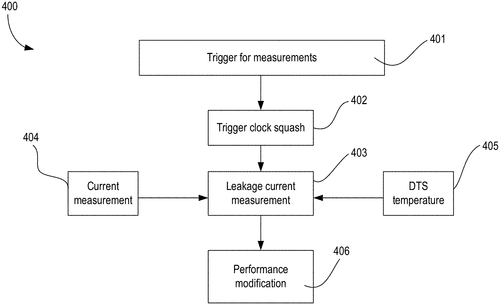
Optimizing Processor Performance with Leakage Current Measurement. Hey there tech enthusiasts! Today, I stumbled upon an interesting patent that aims to revolutionize processor performance management. Say goodbye to sluggish processors and hello to efficient power management! Let me introduce you to a performance management scheme that operates on the detection and correction of leakage current in the field. While it might sound complex at a glance, this scheme holds immense potential for enhancing processor efficiency. The operation of detection involves measuring the leakage current per core, making use of voltage regulator electrical current counters. This means that the scheme can identify which cores are experiencing high leakage degradation and which ones remain relatively unaffected. But, detection isn't the end goal; the scheme also includes an operation of correction. This fascinating aspect changes the processor's power management behavior based on the detected leakage current. One notable example in the patent suggests that processor cores with higher leakage degradation can be logically swapped with cores showing lower leakage degradation. By doing so, this innovative scheme optimizes the processor's overall performance by redistributing workloads more efficiently. Imagine the possibilities this could have for a variety of applications! From smartphones and laptops to data centers and supercomputers, this scheme has the potential to rejuvenate the performance of various processors while minimizing power inefficiencies. Now, here's a question for you, dear readers: Do you think this leakage current management scheme can drastically improve the longevity of processors by extending their operational efficiency? Share your thoughts in the comments below. I'm excited to hear your opinions on how this patent could potentially shape the future of power management in processors. Let's engage in a tech conversation!
This paper discusses a performance management scheme that uses leakage current measurements in the field to determine which cores should be swapped out. If a core is showing high leakage, it may be swapped out for a core with lower leakage. This allows the processor to run more efficiently and reduce power consumption.
US Patent 11703927
Intel Corporation
Securely Modifying Operating Parameters of First Core with Second Core
What is this invention?
Remote register updates
A first core that processes packets
Needs secure parameters to set
So a common key was given
To keep data livin'
And allow the measurements to be met
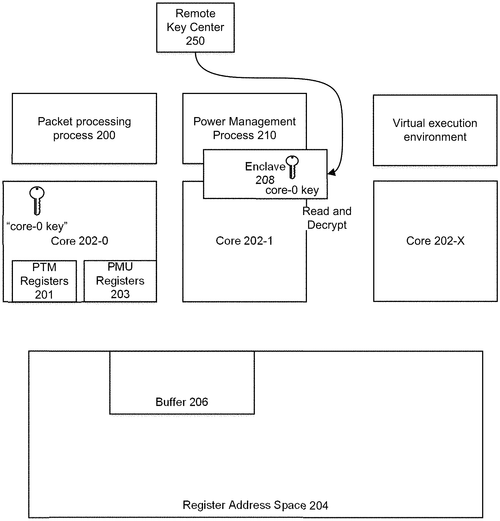
Exciting New Patent Allows for Secure Modification of Operating Parameters. Hello tech enthusiasts! Today, I stumbled upon an interesting patent that seems to offer a solution to a common issue in the realm of packet processing. The patent describes a mechanism where two cores, let's call them Core A and Core B, work together to map the measurement of packet processing activity and potentially modify the operating parameters of Core A. Now, you might be wondering how this is possible without compromising security. Well, the inventors have thought of that too! Core A and Core B are provisioned with a common key during start-up. This key is then used to encrypt and decrypt the measurement of packet processing activity and the shared operating parameters, ensuring that the modification process remains secure. What makes this patent particularly fascinating is that it allows for a different core to modify the operating parameters of Core A based on the measurement of packet processing activity. This opens up opportunities for enhanced performance and optimization, as Core B can dynamically adjust the operating parameters of Core A in real-time. The potential applications of this patent are vast. Imagine the possibilities in networking, where packet processing is vital. With this technology, different cores can collaborate, providing an efficient and secure way to modify operating parameters. Now, here's a thought-provoking question for you, dear readers: How do you think this patent could impact the future of packet processing and networking? Do you see any potential challenges or additional use cases? I look forward to reading your insightful responses in the comments below. Let's engage in a lively discussion on this intriguing innovation!
This document describes techniques for securely modifying operating parameters of a first core while allowing the first core to continue providing measurements of packet processing activity. The first and second cores can be provisioned on start-up with a common key, which allows the first and second cores to encrypt or decrypt measurement of packet processing activity and operating parameters that are shared between the first and second cores.
US Patent 11703933
Intel Corporation
Computer-assisted or autonomous driving vehicles share secrets in social network
What is this invention?
Computer-assisted or autonomous driving vehicles social network
A CASN of CA/AD vehicles,
All connected and in social leagues.
Authenticated or not,
They share data a lot,
In this document they get the keys.
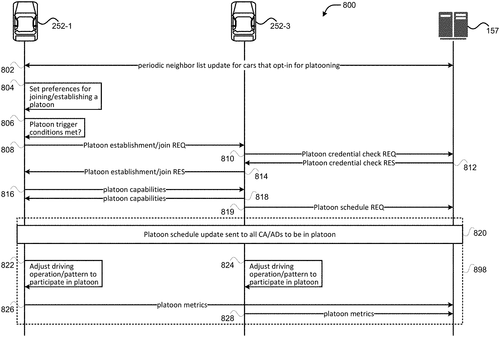
Are you ready to be blown away by the latest invention in the world of autonomous driving? Just when we thought self-driving cars couldn't get any cooler, a new patent has been described that takes this technology to the next level. Buckle up, because we're about to dive into the world of computer-assisted or autonomous driving (CA/AD) vehicles. This patent introduces the concept of a CA/AD vehicle social network (CASN), where these amazing vehicles can form connections and relationships with each other. Imagine your car having its own circle of friends! Just like humans, these CA/AD vehicles can share information with one another. This shared information can include both authenticated and proprietary data, making this network a treasure trove of knowledge. Think about the possibilities! CA/AD vehicles with established connections can exchange important information about traffic patterns, road conditions, and even potential hazards. This means that your car can learn from the experiences of others, making your journeys safer and more efficient. It's like having a virtual co-pilot in your vehicle! But let's not stop there. The patent also mentions other exciting embodiments that are yet to be revealed. Who knows what other breakthroughs await us in the realm of autonomous driving? It's definitely an exciting time to be a technology enthusiast! Now, here comes the question for you, dear reader: How do you envision the future of this CA/AD vehicle social network? Can you see any potential challenges or benefits that may emerge from this interconnected system of self-driving cars? Share your thoughts in the comments below and let's dive into a discussion that will surely drive our curiosity to new heights!
This document describes apparatuses, methods and storage medium for computer-assisted or autonomous driving (CA/AD). In embodiments, CA/AD vehicles are members of a CA/AD vehicle social network (CASN) in which various CA/AD vehicles may form connections or relationships with one another. CASN information shared among the CA/AD vehicles may include authenticated and/or proprietary information.
US Patent 11704007
Intel Corporation
processors include fetch circuitry for executing vector multiplication instructions
What is this invention?
Instructions for vector multiplication of unsigned words with rounding
A processor's task was quite tricky,
For vector multiplication instruction it must picky.
It fetches and decodes,
Then multiplies the loads,
And rounds up to fit in a desticky.
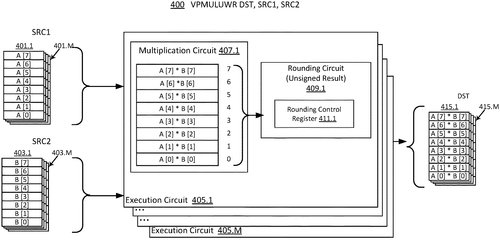
Review:I am thrilled to share with you a groundbreaking patent that promises to revolutionize vector multiplication instructions. This patent introduces a processor that is designed to execute vector multiplication instructions with incredible efficiency and precision. By optimizing the entire process, this innovation has the potential to significantly enhance the performance of various computing systems. The processor described in the patent incorporates several essential components to execute vector multiplication instructions seamlessly. First, it boasts fetch circuitry that retrieves the instruction, which is defined by an opcode, first and second source identifiers, and a destination identifier. This fetch circuitry ensures that the processor receives the necessary information to perform the upcoming vector multiplication. Next, the patent introduces decode circuitry that deciphers the fetched instruction. This step is crucial in guiding the processor on how to execute the operation accurately. By understanding the instruction, the decode circuitry allows for a streamlined and efficient process. The most exciting part of this patent lies in its execution circuitry. This circuitry takes the decoded instruction and proceeds to execute it on corresponding pairs of fixed-sized elements from the identified source identifiers. Notably, it generates a double-sized product of each pair of fixed-sized elements. This double-sized product is represented by at least twice the number of bits of the fixed size, ensuring a more accurate representation. To simplify the results, the execution circuitry generates an unsigned fixed-sized result. It accomplishes this by rounding the most significant fixed-sized portion of the double-sized product to fit into the identified destination. This rounding technique guarantees that the result perfectly fits within the constraints of the destination identifier. Overall, this patent presents an exciting advancement in the field of vector multiplication instruction execution. The processor's fetch circuitry, decode circuitry, and execution circuitry work harmoniously to achieve efficient and precise multiplication. With the potential to improve the performance of numerous computing systems, this innovation is an industry game-changer. Question for the reader: How do you think this patent could impact the future of computing systems that heavily rely on vector multiplication? Share your thoughts in the comments below!
The disclosed embodiments relate to executing a vector multiplication instruction. In one example, the processor includes fetch circuitry to fetch the vector multiplication instruction having fields for an opcode, first and second source identifiers, and a destination identifier. The decode circuitry decodes the fetched instruction. The execution circuitry executes the decoded instruction on each of a plurality of corresponding pairs of fixed-sized elements of the identified first and second sources to generate a double-sized product of each pair of fixed-sized elements. The double-sized product is represented by at least twice a number of bits of the fixed size. The unsigned fixed-sized result is rounded to fit into the identified destination.
US Patent 11704124